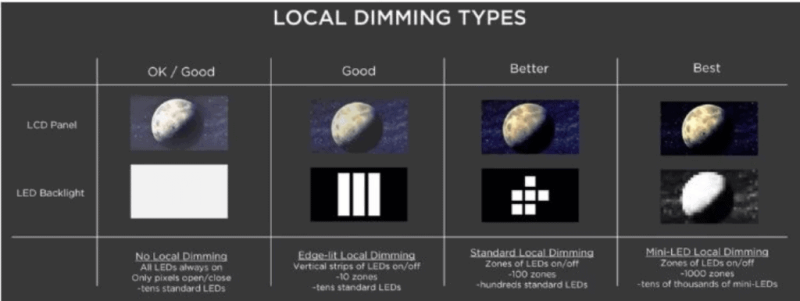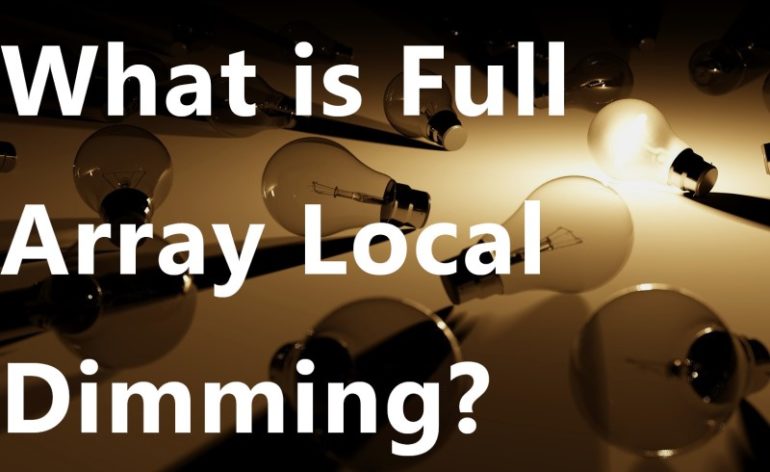What Are Local Dimming Zones and Why are They So Important?
Shopping for TVs can be confusing. Do you really need an 8k display (answer: No)? What about HDR (answer: Yes)? And there are so many specs and features. It can get really confusing if you don’t know what you are looking at or why. In particular, we often talk about local dimming zones. These seem to be highly regarded by “those in the know” but not all TVs have them? So, what’s the deal? Do all TVs have them? Do they need them? And what the heck are local dimming zones and why are they important?
Local Dimming Zones: A Definition
Local dimming zones, or sometimes referred to as Full Array Local Dimming, are the number of individual lights that are used to illuminate the screen. In an LCD display (LED, QLED, QNED, Neo QLED are all LCD displays), there needs to be a backlight. The LCD panel is (for brevity’s sake) a bunch of windows. When you want light to pass through a specific pixel, that window opens. A filter is used to give the light color. Want to know more? Check out this article for a more technical explanation.
Now, as you’d expect with a bunch of windows, they don’t all shut perfectly. When they are all closed, a little light can leak through. This was commonly called the “screen door effect” when LCDs first hit the market. Newer LCD panels have all but eliminated the problem. But with one large backlight, the LCD screen is expecting the “window” to block out all the light when trying to create a black (or mostly black) image.
The Problem With LCDs
What you end up with is dark grey. The screen door effect of seeing a grid of light around the windows may not be happening, but there is still enough light leakage that blacks never really look black.
This is most notable with images that have high contrast in small spaces. A starfield for example. The stars are very, very bright and the black space around is very black. Without local dimming, the blacks will never be truly black. Like so:

This is an extreme example but highlights the problem. Without the local dimming to completely turn off the backlight in the black areas, the blacks end up grey or even blotchy. With local dimming, that is no longer an issue.
The different names for LCD TVs out there (LED, QLED, Neo QLED, QNED, etc.) are all referring to the backlight type. These are just different solutions to the backlighting problem. Sometimes these new technologies lead to brighter backlights, sometimes to more zones of dimming. Either way, it isn’t so much about the backlight as it is about how many zones the display has. More is better when the light is coming from the back (not the sides).
Not All Backlights are Created Equal
So just look for the number of local zones of dimming and get the display with the highest number, right? More zones mean more lights that can be turned off and better contrast. Well, that is technically true, but you also need to pay attention to the type of backlight.

There are essentially two different types of backlight with LCDs – Edge and true backlight. An edge backlight is exactly what it sounds like – a light that comes from the edge of the screen. This could be on as few as one edge or all four. As you might expect, this creates inconsistent illumination with the edges being slightly brighter than the center. Why use this type of backlight? Well, it is cheap and it allows manufacturers to market very, VERY thin LCD TVs. If all you care about is how thin your TV is, edge lighting is for you.

A true backlight is one that comes from behind the screen. It may be a single light or a number of lights. What you are looking for when shopping for an LCD TV is one that had lots of local dimming zones and also a full array of backlights. These will often (but not always) be labeled as FALD – Full Array Local Dimming. This indicates that there are not only local dimming zones, but a light for each one.
What About OLED?
OLEDs are the most expensive TVs out there right now, but they don’t ever talk about local dimming or any of this stuff. Is that because OLEDs are somehow inferior?
The reason that OLEDs don’t talk about local dimming or FALD is that it is a self-emissive display. That means that each pixel has its own illumination. In essence, the “local zones” are each pixel. In a 4k display, that is over eight million “local zones.” You literally can’t have more. That is why OLEDs have the best contrast and cost the most. Their black levels can’t get any better because each pixel can turn completely off.
Bottom Line
What LCD TVs (regardless of backlight type) are trying to do with local dimming zones is to get as close to the OLED performance as possible. Look for the highest number of local dimming zones and make sure the panel is FALD. You’ll end up paying more than an edge-lit or a no-zone TV, but you’ll also end up with a much better picture.


